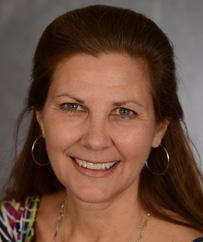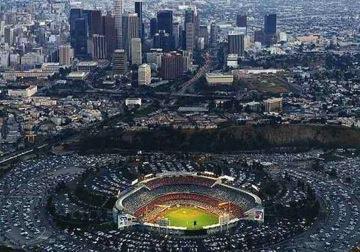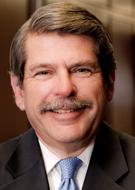With LA's baseball season about to begin, the Dodgers held a ribbon-cutting to reveal improvements to the stadium. TPR has included background information on the upgrades and a transcription of the event, featuring Dodgers President Stan Kasten, Dodgers Senior Vice President Janet Marie Smith, and former baseball player/Dodgers Manager Tommy Lasorda. Accompanying this, TPR has provided an overview of the neighboring community's traffic concerns, along with a question-and-answer session on that topic held with Smith.

Janet Marie Smith
"All of this is part of a strategy to help elongate the fan experience, to give our Dodger fans more for the price of their ticket, and to give them something to celebrate here at Chavez Ravine that really does embellish the history of the Dodgers." —Janet Marie Smith
 The 2013 season was quite a remarkable year for the Los Angeles Dodgers. Their first full season under new ownership left an indelible mark not only on the team and its expanded fan base, but throughout the City of Los Angeles, as well. As they prepare to open this season with more than 3 million tickets sold before opening day and over 75 percent of their games over 40,000, the excitement for a World Series Championship is palpable. But, equally important, the economic impact for the city of Los Angeles is evident, particularly for the restaurants and bars along Sunset and in Echo Park.
The 2013 season was quite a remarkable year for the Los Angeles Dodgers. Their first full season under new ownership left an indelible mark not only on the team and its expanded fan base, but throughout the City of Los Angeles, as well. As they prepare to open this season with more than 3 million tickets sold before opening day and over 75 percent of their games over 40,000, the excitement for a World Series Championship is palpable. But, equally important, the economic impact for the city of Los Angeles is evident, particularly for the restaurants and bars along Sunset and in Echo Park.
However, as with most success, it doesn't come without its challenges. More fans means more traffic. Thus, while the Dodgers have spent the offseason on additional stadium improvements, they have also focused their efforts in partnership with the City of LA, LA Metro, LAPD and the community on a multimodal transportation and neighborhood protection plan to ensure they are doing everything they can to get their fans off the public streets and into their stadium as quickly as possible while protecting their local neighbors.
At a ribbon-cutting event on March 26, Dodgers representatives unveiled the newest improvements to the stadium, completed in preparation for the season opener. The efforts to upgrade the physical space began in 2013, after Guggenheim Baseball Management purchased the team in 2012. After creating a wish list of initiatives, the new ownership began with improvements to the home team’s clubhouse and the expansion of player amenities, as well as revamping the Top deck and Reserve Level with new plazas, kids play areas, team stores, concessions, ticket offices and new restrooms. In addition, each concourse was widened by eliminating several rows of seating to create standing areas/drink rails and disabled access seating.
Following the completion of these initiatives in 2013, the Dodgers began a second round of improvements, which have now been realized. These range from upgrades to the visiting team’s clubhouse, to the development of new plazas in the outfield with bullpen overlook bars, new stores, and expanded concessions including the much-anticipated introduction of Tommy Lasorda’s Trattoria, named after the legendary baseball player and Dodger manager. At the ribbon cutting, setting the stage for another remarkable season, those in attendance celebrated this new phase in Dodgers history. They called attention to physical improvements with the implication that a revitalized stadium has and will continue to improve the experience for fans—drawing in greater numbers that won't just benefit the team, but will also benefit the city that brought baseball to the west coast.
Dodgers Stadium March 26 Press Conference MC:
We are back on US soil. We have the best record in baseball and had a very successful trip to Australia, so life is good for the Dodgers, and we’re happy that you can be a part of this.
It’s March 26, and Dodger Stadium looks a lot different than it did just a few months ago. Certainly, fans who came to the park last year saw a lot of remarkable changes, and obviously 2014 is bringing even more changes to Dodger Stadium. We’re going to be hearing from the people that were in charge of making these upgrades possible, but we’ll also hear from the people that are making sure that what fans love about Dodger Stadium doesn’t change.
We’ll first hear from the man whose name is synonymous with not only the Los Angeles Dodgers but also with Dodger Stadium itself. To get things started, it is my privilege to introduce team president and CEO, Stan Kasten.
Stan Kasten:
Thank you all so much for being here as we unveil some of the improvements this year at Dodger Stadium, starting with the thing we are perhaps the most proud of—both of these bullpen bar areas, but especially this one, the opening of Tommy Lasorda’s Trattoria, which is yet another restaurant Tommy doesn’t have to pay to eat in!
After you sample the food, all of which Tommy has personally approved, you’ll see on the wall a fantastic gallery of pictures of Tommy throughout the years.
What we’ve set out to do, ever since I’ve gotten here, is to improve the stadium for the fans. We love Dodger Stadium. We love the sightlines. It’s a great place to sit and watch the game for nine innings. But if you want to get up and stretch your legs, or if you wanted to have a little change in experience, the stadium lacked those kinds of alternatives when we got here.
Last year, we expanded the upper entries, and we put kids play areas in. This year, we were able to get down to the field level, and we added these magnificent 25,000 square-foot plazas on each side with retail and concessions.
These bullpen bars are fantastic. I encourage each of you to get a look. They’re non-ticketed, and they’re open for everyone on the Field level, Loge, Reserve, or Club. I know everyone’s going to enjoy them.
This bar that you see behind me—here’s how the idea began. I looked down at this area and said to Janet, “That’d be a great place for a beer cart and an umbrella.” That’s how it began. By the time Janet got finished with it, this is what we have, and it’s spectacular.
Both sides are fantastic. On right field is Tommy’s Trattoria. On left field is fresh barbeque right off the grill. We invite you to check them both out and, of course, recommend them to all fans who are going to enjoy them all season and beyond.
Janet Marie Smith
We all thoroughly enjoyed putting together this umbrella and cart for Stan. Stan had said from the very beginning that he really wanted to make this place more accommodating for fans—that it’s always been known as truly the best place to watch baseball in America, but there wasn’t a lot to recommend it in terms of the fan experience beyond how great the seats were and how beautiful the setting was. One of the things that Tommy Lasorda has been saying ever since we walked through the door is, “Get in here early. Give them something to eat. Give them something to do. Then, they don’t have to sit in traffic. Same in the reverse.” All of this is part of a strategy to help elongate the fan experience, to give our Dodger fans more for the price of their ticket, and to give them something to celebrate here at Chavez Ravine that really does embellish the history of the Dodgers. Another thing that Stan Kasten said to us from the beginning is, “Let’s go all the way back to Brooklyn. There’s a lot we can work with here.”
On behalf of the design team, which included D’Agostino Izzo & Quirk, Levin & Associates, Mia Lehrer and Associates, Younts Design, our structural engineers, Nabih Youssef and M-E, our MEP engineers, we were thrilled to be given a chance to put this together and continue what we started last year with the plaza at the top deck and the Reserve Level. Tommy Lasorda, we thank you for giving us so much good material to work with. There’s never been anything as much fun as putting together “Blue Heaven on Earth,” Tommy’s pet name for Dodger Stadium. By the time you show up here a week from Friday for the true opening day, there’ll be 88 blue lights in this plaza that will illuminate it at night so that it really will be blue heaven on Earth.
Finally, I want to thank PCL, our construction managers. They did a superb job. We didn’t start construction on this season’s work until the beginning of January, so in a mere 12 weeks, they put together not just the plaza—the overlook bars, stores, and concessions—but also other behind-the-scene projects, like the visiting team clubhouse and the expansion of LA Taqueria on the Reserve Level. I urge you to walk around and take in all there is to see. Vin Scully was right—it really is just the most beautiful place in the world. We’ve also tried to respect Walter O’Malley’s vision by adding many more trees. I hope you feel that, as you walk around, we have honored the notion of bringing the beauty of Elysian Park into Dodger Stadium.
Tommy Lasorda
Thank you very much. They’ve named highways after people, they’ve named buildings after people, and they’ve named streets after people. But, what’s better than having a restaurant named after you? I have so many people to thank, particularly Stan, our president, Lon Rosen, Bob Wolfe, and all the guys that made this possible today. Best of all, everybody is going to feel good eating that Italian food.
The impact of game-day traffic on the neighborhoods surrounding Dodger Stadium has long been a concern of residents. LA County Supervisor Zev Yaroslavsky explained the context in a post to his website:
 “Although game-day traffic is always heavy around Chavez Ravine, it was particularly challenging last year. Attendance soared to its highest level in seven years—nearly a million above its 2011 low point, when San Francisco Giants fan Brian Stow was brutally beaten in a stadium parking lot in the season’s early weeks. With new owners and a powerhouse lineup that notched an epic winning streak, the Dodgers became one of the hottest tickets in town virtually overnight…
“Although game-day traffic is always heavy around Chavez Ravine, it was particularly challenging last year. Attendance soared to its highest level in seven years—nearly a million above its 2011 low point, when San Francisco Giants fan Brian Stow was brutally beaten in a stadium parking lot in the season’s early weeks. With new owners and a powerhouse lineup that notched an epic winning streak, the Dodgers became one of the hottest tickets in town virtually overnight…
[Aram] Sahakian is a student of the stats. He knows, for example, that when the number of cars per hour, per lane, exceeds 1,200, “speed starts slowing down and you get into a gridlock, standstill type of situation.” That string of 40,000-ticket games for this season? He says they’ll easily push the streets beyond their free-flowing capacity, requiring a game plan every bit as nuanced as the one Dodgers skipper Don Mattingly will create for his crew.”
Concern in the communities surrounding the stadium mounted after Dodger representatives announced that, for the first time in nearly 20 years, they will reopen Gate B on Scott Avenue to cars. A group called Concerned Citizens of Echo Park have circulated a petition against this reopening. At the March 26 ribbon cutting event, Janet Marie Smith spoke with the press about the implications of an open Gate B, and efforts the Dodgers are making to encourage non-car forms of transportation to and from games:
Press Question: Why are you re-opening Gate B at Scott Avenue?
Janet Marie Smith: Dodger Stadium, which seats 56,000 fans, only has five gates. To have a full 20 percent of those gates closed all these years has really hurt our ability to get fans in and out faster. I think what we want to underscore is that we hope this isn’t the focus. We hope the focus is on trying to use other modes of transit to get to Dodger Stadium. We’ve really been pushing the Dodger Shuttle Express. We’ve got two stops here at Dodger Stadium. We’re trying to encourage our fans to use the Number 2 and Number 4 buses on Sunset, as well as the Chinatown metro. We’ve put in new pedestrian entrances, new bike entrances, new lighting, and new landscaping at every gate in hopes that we can make each entrance very attractive to everyone. Our overarching goal is not to bring more cars through the neighborhoods, but to get them off of Sunset and off of I-110, in particular, faster.
Press: The statement that the Dodgers put out talked about an effort to usher people along Stadium Way and not let them into the neighborhood. Is that right?
Janet Marie Smith: I’ll underscore that Scott is not being reopened between Glendale and Stadium Way. We are opening Stadium Way so that we can take the cars off of Sunset that pile onto Elysian Park Avenue, pulling the left two lanes off of Elysian Park Avenue around on Stadium Way and into Gate B. They’re still coming from Sunset—it just essentially takes a five-lane road and turns it into a seven-lane road.
Press: Dodger attendance is expected to be up.
Janet Marie Smith: It is. We’re thrilled with the attendance. We’ve sold over three million tickets already. We’re sure that more than 75 percent of our games will be sell-outs and we’re delighted that the team on the field demands that kind of attention.
Press: Neighbors are upset, though. They say it’s going to create more traffic for them. Is that a viable argument?
Janet Marie Smith: I think the emphasis I would place is that if we do better, there are more people coming, however they come—buses, on foot, bicycles, or cars. What we don’t want is to have them linger in neighborhoods. That’s the whole point of trying to get them off the streets as fast as they can and onto our property if they’re in cars, on foot, or on bicycles.
Press: When do you hope to have the gate open?
Janet Marie Smith: We hope to start that immediately. We’d like our fans to get used to the idea that they come in via Elysian Park Avenue, as they have for 53 years. They will be able to essentially expand the number of lanes and pull them in via Gate B. But, I do want to underscore that it is via Elysian Park Avenue. It’s not via Scott.
Press: Lastly, to be clear, which game would that be?
Janet Marie Smith: We’re hoping that we’ll be ready to start that for the exhibition games. That’s what exhibition games are about—trial runs, whether you’re dealing with traffic, food, new ushers, new attendance, or even the players on the field.
- Log in to post comments



